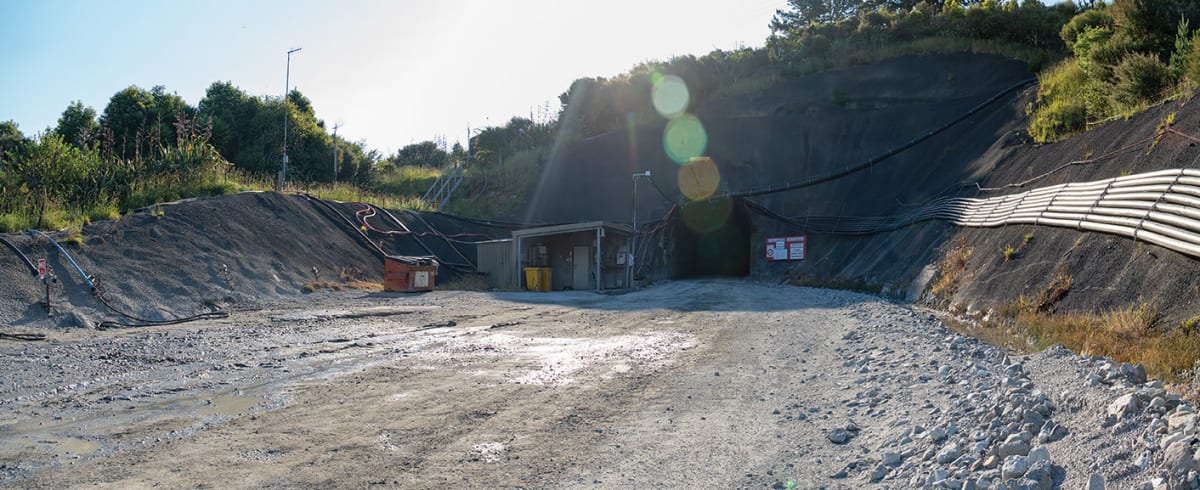
There were thought to be as few as 5000 of NZ's tiny Archey's frogs, but new eyebrow-raising research published by multinational minerals company OceanaGold says there are more than 50 million
Listed as critically endangered, mainland New Zealand's only terrestrial frog has been at the centre of a massive conservation effort. First identified as a unique species in 1942, it's a nocturnal master of camouflage found only in small patches of forest in the King Country and Coromandel.
Auckland Zoo and Waikato Regional Council have both set aside funding to help study and protect the "enigmatic" frog in the past year, and they're not alone. An international gold-mining company has funded a big population study, published this week – but doubt is being cast on its findings.
The research is led by the longtime Department of Conservation ecologist Dr Brian Lloyd, now turned private consultant. Extraordinarily, it finds official estimates of 5000 to 20,000 Archey's frogs are massively understated. His modelling concludes there are more than 50 million in the wild.
The research comes as part of a resource consent application by OceanaGold, for a new underground mine north of Waihi.
It extrapolates from 381 records of Archey’s frog sightings, most of them from a 578 sq km block of native habitat in Coromandel Peninsula’s mountain range, including the predicted vibration footprint of the proposed Wharekirauponga mine.
"Our best estimate for the total Coromandel Archey’s frog population is 54.8 million frogs," Lloyd's report concludes. "This is several orders of magnitude greater than a previous estimated total NZ population of 5000 to 20,000 mature frogs in the New Zealand Native Frog Recovery Plan."
“This creature was more than a statistic – it was a unique expression of our link to the ancient world.” – Catherine Delahunty, Coromandel Watchdog of Hauraki
Beneath the frogs' habitat is thought to be one of the largest seams of gold found north of Waihi, according to OceanaGold. The proposed mine has divided opinions in the Coromandel. On the one hand, there are those who welcome the several hundred promised jobs, and billions in export revenues.
On the other hand, there are grave concerns about the impact on the conservation land above the mine, and the flora and fauna that inhabit it. Specifically, the heavy metals, the effect of draining water from the forest, and the impact of the vibrations on the frogs.
OceanaGold insists it can build and operate the mine "with minimal to no impact". It would include the underground mine and a 6.8 km tunnel to access it, a portal entrance on company land 5km north of Waihi, an open pit directly to the west of an upgraded processing plant, a third tailings pile and a rock-storage facility.

The sometimes controversial mining company (it's in regulatory disputes in the Philippines and El Salvador) has applied for resource consent to bore beneath the frogs' forest park habitat. On Friday, Waikato Regional Council formally accepted the application as complete under s88 of the Resource Management Act.
Council spokesperson Wendy Valois says the application, including the data on Archey's frog, is being assessed by council staff with the support of a number of external technical experts.
Already, it's raising some eyebrows, and concern that the report is framed to smooth the mine's resource consent approval process. Avi Holzapfel, the Department of Conservation's operations manager for Hauraki, says all their other observations and research point to the frog's population declining.
“Some findings in the consultant’s report are surprising, especially the large estimate of the Archey's frog population size," Holzapfel says. “Some findings are at variance with widely held scientific opinion on the species, and the experience and observation of our staff who’ve worked on the ground in Wharekirauponga."
Entertainment personalities Guy Williams and Morgan Donoghue have been fronting a campaign demanding the Government uphold its promise of no more mining on conservation land.
Catherine Delahunty, chair of Coromandel Watchdog of Hauraki, says the research provides 50 million reasons not to mine.
"Although our population estimate is based on sparse data and untested assumptions, it is the best estimate possible with available data, and is more credible than the 5000 to 20,000 estimate. A more reliable estimate than ours would require a well-designed study programme with extensive and intensive field work." – Dr Brian Lloyd, report author
Archey's frog is special, and a taonga to iwi, says the former Green MP. "Strangely when I saw my first Archey's it was in the Koru Lounge," she recalls.
"The late Dr Phil Bishop was travelling with a couple of fingernail-sized examples of the 200 million-year-old species. He showed me this tiny life form and suddenly this creature was more than a statistic – it was a unique expression of our link to the ancient world.
"Archey's are a taonga species living in a forest where they barely move a square metre in a lifetime, unless we create disturbances. In the past, the species has nearly collapsed from disease and disturbance, so why would we do that again?"
She warns that dewatering the forest where a population of Archey's frogs lives, and blasting beneath their largest habitat, is not going to help the species recover.
At a recent meeting, Department of Conservation staff told her group that the species was struggling. So she says it's hard to know whose figures are correct. She calls for independent data from groups such as the Amphibian Survival Alliance and International Union for Conservation of Nature scientists.
Delahunty says the 27-page research report is based on a number of assumptions as opposed to solid data. "But even if there are many more frogs than previously thought, this precious population of an at-risk species needs to be left in peace.
"They have found more Archey's than anyone expected in the limited areas studied and have done some maths based on this work. They have claimed vibration won't hurt the frogs based on very limited data on low-level blasting at the Golden Cross mine, but it's not clear that population monitoring in that area is robust before and after that failed mine."
Lloyd defends the findings of his study: "Although our population estimate is based on sparse data and untested assumptions, it is the best estimate possible with available data, and is more credible than the 5000 to 20,000 estimate. A more reliable estimate than ours would require a well-designed study programme with extensive and intensive field work."
“If the numbers were correct, we’d expect to find Archey’s frogs everywhere in the entire potential Coromandel habitat." – Avi Holzapfel, Department of Conservation
The first question for OceanaGold Group's environmental manager goes almost without saying: how credible are the findings, given they come from a mining company with an obvious vested interest?
The report is published by the mining company, not in a peer-reviewed journal. So Queensland-based Kerry Watson responds indirectly, by pointing to Brian Lloyd's credentials as the published author of other research papers and publications on New Zealand fauna, and as an expert witness at Environment Court hearings.
"As part of our resource consent application we have worked with independent researchers to better understand the environment we are proposing to work in, the potential for our project to impact the environment and how we might mitigate or eliminate the potential impacts," he says. "These studies will all be tested by an independent panel through the consent process."
He argues the findings make no difference to the risk profile of the Waihi North mine proposal, and the "rigorous permitting and consenting process" the company must go through.
"We are pleased to have been able to provide more data and insight to the species and into the scientific community. None of our commitments to operating responsibly, including making sure we have minimal surface impact to flora or fauna, have changed."
Those commitments, to mitigate risk to the frogs, include dedicated funding for scientific research and for pest control that, Watson says, will help protect other native species as well as the Archey's frog.
An OceanaGold public relations consultant declined to facilitate an interview with Brian Lloyd, saying the report's author wouldn’t comment beyond what he had published in the research.
But Avi Holzapfel expands on the Department of Conservation's concerns.
“We would welcome research convincingly demonstrating Archey's frogs occur in greater numbers than we thought," he says. "However, we remain cautious about the claimed results and population figures given the report states they are the 'best estimate' based on 'sparse data and untested assumptions'. It’s also important to note this is a consultant’s report, not published peer-reviewed science."
He says the report uses data collected at very small sites, and extrapolates it over the entire potential Coromandel habitat the species is found in. It also extrapolates known population figures and records of the species out over time and over a much wider area of the Coromandel, rather than the specific locations.
“If the numbers were correct, we’d expect to find Archey’s frogs everywhere in the entire potential Coromandel habitat the species is found in – and our observations are that’s not the case."
Since the 1950s, he says, research has repeatedly shown the frog in decline.
“Calculating population data of any cryptic species is challenging," he adds. "Although this report includes new data which will be scrutinised, it is far too early to say whether it is accurate."
“Studies at Coromandel and Whareorino have shown the frogs can be found in high density at specific sites, but do not lead to the assumption the same density occurs even a short distance away.”








